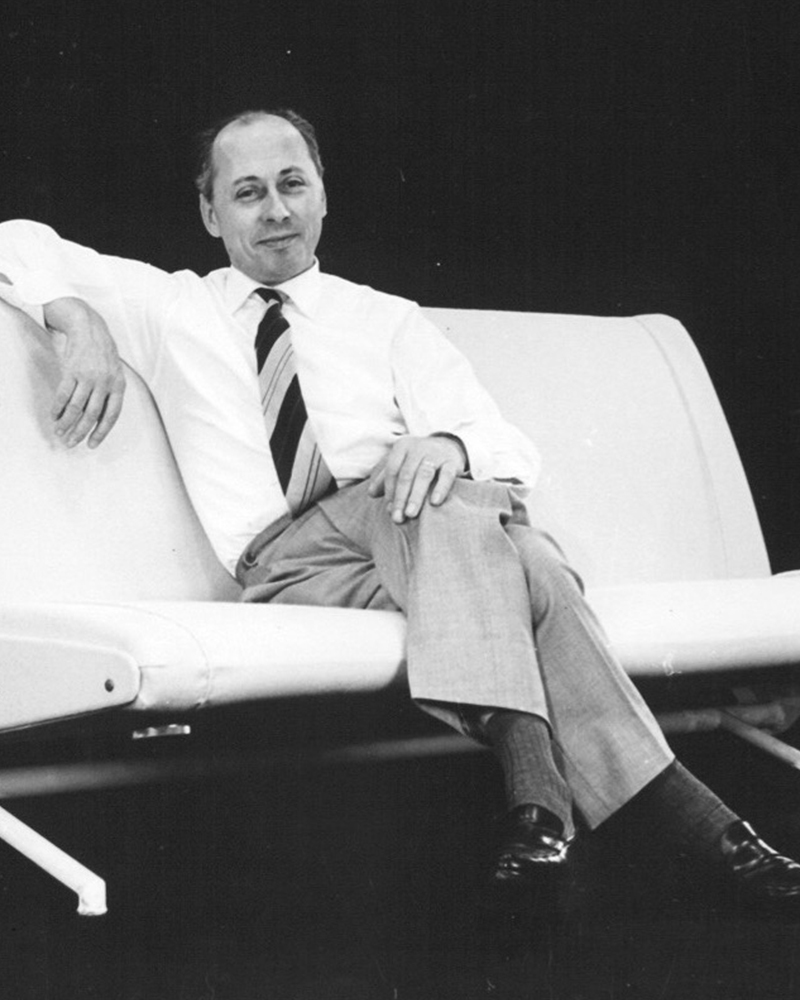Side Gallery
Side Gallery
WishlistFollow
Follow

Osvaldo Borsani (born 1911, Varedo, Italy–died 1985, Milano, Italy) was an Italian designer and architect. Osvaldo Borsani was born into a family of artisan furniture makers. His father, Gaetano Borsani, owned a furniture shop, the Atelier di Varedo, where the 16-year-old Osvaldo first started to train. At the time, a designer working at the atelier was the architect Gino Maggioni, who influenced the early 20th century Jugendstil movement from Vienna and instilled in the young Borsani an appreciation for the arts and crafts and furniture making.
Osvaldo Borsani studied Fine Arts at the Accademia di Belle Arti di Brera in Milan, graduating in 1931, he then studied Architecture at Politecnico di Milano, where he graduated in 1936.
In 1933, two years before graduating as an architect, Borsani designed the Casa Minima project for the V Triennale di Milano (Milan Triennial), collaborating with Cairoli and Varisco's architects. This project earned him a silver medal for its Rationalist code and geometries, and he received positive reviews from the critic Edoardo Persico of Casabella magazine.
In 1937, Osvaldo Borsani designed Villa Presenti in Forte dei Marmi, a seaside home in Tuscany where the Italian aristocracy and industrial elite often built their houses. It was a project that displayed the same rationalistic rigor as Casa Minima, but was softened with Mediterranean colors and materials.
In 1943, Osvaldo designed and built his own house, the Villa Borsani, in Varedo, which, despite being conceptualized with strict Rationalist principles, assimilated objects and art of younger artists that conversed a more gentle approach to the human expression. The Villa Borsani project incorporated the work of artists such as Adriano Spilimbergo, Fausto Melotti, Lucio Fontana (who made the ceramic fireplace and the ceramic Madonna), and Agenore Fabbri (who made the bronze statue in the staircase). To this day, Villa Borsani has been preserved with most of its original furniture, and it remains in the hand of Osvaldo Borsani's family, along with extensive archives of his work.
After Villa Borsani, Osvaldo continued to develop many projects for the Milanese bourgeoisie, always incorporating the same artist's work. He developed a particularly strong relationship with artist Lucio Fontana, a close friend since his time at the Accademia de Belle Arti di Brera. Borsani assigned Fontana to make a large balcony for the Tecno company in 1956.
Like his architectural projects, Osvaldo Borsani's design work often drew inspiration from artists and designers such as Roberto Crippa, Arnaldo and Giò Pomodoro, Agenore Fabbri, Fausto Melotti, Andrea Cascella, and Lucio Fontana. Borsani's collaboration with Lucio Fontana resulted in many of Borsani's furniture designs in the late 1930s and 1940s. With Fontana, Borsani integrated sculptural ceramic and bronze elements, wood and gilded stucco, and interventions on glass tabletops with decorations, to name a few design elements, to his furniture designs.
In 1953, Osvaldo understood the imminent need to transform the artisan approach to furniture into a modern industry capable of meeting increasing demands at more accessible prices. It was then that Osvaldo and his twin brother Fulgenzio founded the manufacturer Tecno to incorporate modern manufacturing techniques that would deliver high-quality furniture to a larger international market. Initially, Tecno manufactured only Borsani's furniture designs, and the company continued to design furniture and objects until the early 1980s. However, in the late 1950s, Tecno also manufactured furniture from other designers, including Vico Magistretti, Roberto Mango, Gae Aulenti, Eugenio Gerli, Carlo de Carli, and Gio Ponti.
Among the most successful and iconic Tecno designs are the 1954 D70, a sofa that can be used in approximately 20 positions; the 1955 P40 adjustable chair, described as a "machine for sitting," which could assume 486 distinct postures; the 1954 T41 dining table; the 1961 AT 16 coat rack; the 1965 Canada chair; the 1968 Graphis office furniture system; and the 1972 P128 office chair.
Along with Eugenio Gerli, Marco Fantoni, his brother Flugenzio, and his daughter Valeria, Osvaldo Borsani founded Centro Progetti Tecno (1970), a design shop focused on creating innovative products and interiors for work and school environments.
Early furniture pieces by Tecno can be found in the permanent collections of the MoMA in New York, the Victoria & Albert Museum in London, the Centre Pompidou in Paris, the Trienalle di Milano Museum, and the Neue Sammlung in Munich.
In 2018, the Triennale di Milano organized a retrospective of Osvaldo Borsani’s work. The exhibition "Osvaldo Borsani" was co-curated by Tommaso Fantoni, Borsani's grandson, and Norman Foster. They had worked with Borsani at Tecno, where he designed the Nomos table and furniture systems for airport and museums.
ENQUIRE ABOUT THE DESIGNER